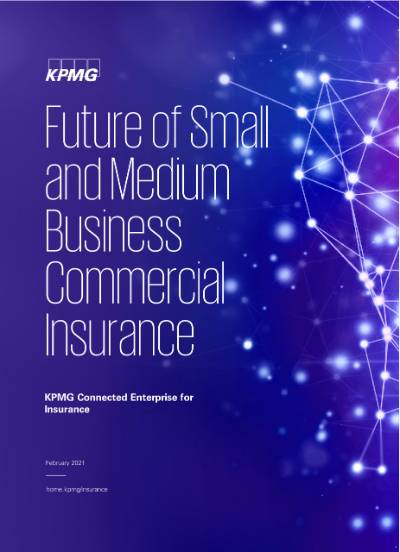The COVID-19 pandemic has disrupted businesses of all shapes and sizes around the world. For small and medium businesses (SMBs) it has posed particularly significant challenges, given their typically thin cash reserves and dependence on a small number of routes to market. SMBs also tend to have relatively low levels of business insurance, viewing it as a cash outflow that may not provide them with the benefits they actually need.
However, the pandemic has served as a powerful demonstration of the value of insurance protection and many SMBs are likely to be reviewing their arrangements in its wake. This creates significant opportunities for insurers who can provide the right range and choice of cover, through the right channels, at the right price.
Those insurers that can drive a truly differentiated SMB proposition - putting the segment’s business needs and customer experience at the heart of everything they do, and connecting it across the enterprise ― have the potential to secure a significant competitive advantage.
It is this notion of becoming a Connected Enterprise that we explore in this report, setting out the hallmarks of Connected Insurance in the small business context. We explore how this may manifest itself across what we see as the three likely dominant ways of working for small business insurance in the new reality we are entering.
The trends we discuss are not new, but they have been significantly intensified by COVID-19. High on the agenda is the need for insurers to bring SMBs more seamless and integrated digital products and services, combining value, convenience and a range of packaged benefits. To do this, insurers need to leverage the power of data to anticipate and meet emerging customer needs, and work fluidly in a wider ecosystem of partnerships and alliances to bring related and complementary solutions.
These abilities all depend on having a Connected Enterprise in which eight key capabilities power a customer-centric approach. Everything is focused on meeting customer expectations and needs. Front, middle and back offices are aligned and create business value, driving sustainable growth.
Becoming a Connected Insurer takes commitment and determination. To truly serve the small business segment, achieving it has become more important than ever before. It is the key to providing SMBs with the dynamic and flexible value they need.
Signals of change


Shifting business models
To respond to signals of change, and protect their market presence, traditional insurance players with small business market ambitions must now rapidly pivot their ways of working and develop their capabilities in three key respects - modular and tailored business mo.dels, digital first ways of working and affiliate/embedded products and partnerships.
Doing nothing is not an option. In an increasingly active space, those who simply retain their old ways of working are likely to suffer an increasingly diminished SMB book, as small business owners switch to more bespoke protections that are more dynamically molded to their real business needs.
01
Modular and tailored business models
Insurers will offer small business customers coverage that is flexible and highly targeted to specific business needs. Products will be modular in that customers can select and opt-in for coverage and features they require, at price points that suit them, building their own bespoke packages. There will be on-demand and pay as you go features too, enhancing flexibility further. Products will be tailored such that certain cover is designed for specific sectors, professions or sub-sectors rather than one-size-fits-all across all corporate customers. Other benefits will be bundled in, such as wellness, planning and prevention services through an ecosystem of providers and partners. Services will be delivered through an omnichannel model with a high emphasis on frictionless digital pathways that enable SMB customers to access products, services and information any time, anywhere and in a way that suits them. Internal processes will be highly digitized too, enhancing employee productivity and the quality of the working experience.
02
Digital first ways of working
To provide the flexibility and responsiveness that small business customers are looking for, insurers will need to adopt highly digital models of service and delivery. Products and services must be easily accessible and manageable across devices and through web-based portals and apps, in addition to phone or in-person (broker, agent) service. Automation will be embedded where applicable to make the customer’s journey easier, faster and more intuitive. A high degree of self-service will be enabled. Bundled products and services that solve an end-to-end need will be digitally available in a unified purchase experience and within a single price point. Leveraging their partnership ecosystems, insurers will be able to offer real time bundling and pricing enabled by API-based architecture and micro-services. Automation platforms, process efficiencies and real-time data insights will empower the workforce; collaboration internally between teams and externally across partner networks will drive new innovation and customer-centric product and service enhancements
03
Affiliate embedded products & partnerships
In a rapidly evolving and digitally-enabled marketplace, no single player will be able to meet all customer needs on their own. Partnerships and affiliations will therefore be indispensable. These will enable insurers to offer insurance products at point of purchase for other goods or services where there is a related need: cyber insurance when buying IT equipment, for example, or business interruption cover when purchasing fire & safety goods or services. Embedding insurance as part of a purchase within an extended ecosystem of sales will increase insurers’ penetration and bring their brand to customers in highly relevant contexts, increasing customer engagement and boosting their perception of the value of insurance. Insurers will need to develop unified virtual platforms with partners such as retailers and business service providers, enabling seamless interactions across ecosystem touchpoints. They will need to leverage data insights to drive up cross-sell and up-sell opportunities. With some major platform retailers beginning to offer insurance as an incremental purchase to customers themselves, developing these alliances and partnerships will become increasingly critical.
Strategic imperatives and impacts
In order to deliver on these strategic themes, KPMG professionals have identified eight capabilities that, together, align the operating model to focus on delivering value to the customer and the business. These are cross-functional and apply across the operating model. Our recent research conducted by Forrester Consulting found over half (52%) of respondents are investing in at least six customer-centric capabilities.
Eight capabilities, twice as likely to succeed
The eight capabilities of the KPMG Connected Enterprise deliver tools, methods and frameworks to achieve a new, better business as usual with agility and accelerated innovation. They are enterprise-wide and will align the operating model to focus on delivering value to the customer and the business.
Base: 1,299 professionals involved with customer-centric strategy decisionsSource: A commissioned study conducted by Forrester Consulting on behalf of KPMG, September 2018.
- 2xImpact
Our approach
Each of the eight enabling capabilities are underpinned by a set of sub-capabilities. The first step in defining a winning model is understanding your relative maturity in each against the required maturity to deliver your winning business model. KPMG firms offer three levels of maturity diagnostic depending on the needs of your business. Contact your local advisor today.
With the customer at the core, there are five critical questions insurers should ask themselves:
Are you connecting your customers with compelling and personalized value propositions, opportunities and interactions?
Are you connecting and empowering your employees to deliver on the customer promise?
Are you connecting your front, middle and back offices to execute the customer growth agenda?
Are you connecting your ecosystem of business partners to jointly deliver on commitments to customers?
Are you connecting to market dynamics and digital signals?







